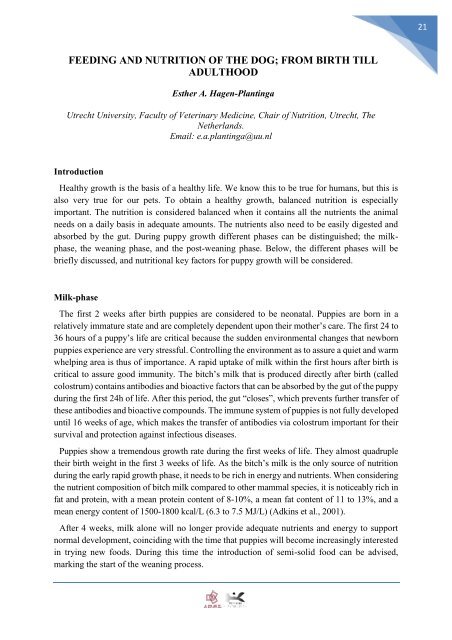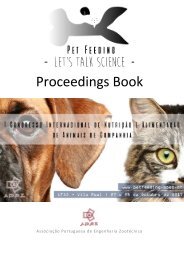Book of Proceedings I PetFeeding
Create successful ePaper yourself
Turn your PDF publications into a flip-book with our unique Google optimized e-Paper software.
21<br />
FEEDING AND NUTRITION OF THE DOG; FROM BIRTH TILL<br />
ADULTHOOD<br />
Esther A. Hagen-Plantinga<br />
Utrecht University, Faculty <strong>of</strong> Veterinary Medicine, Chair <strong>of</strong> Nutrition, Utrecht, The<br />
Netherlands.<br />
Email: e.a.plantinga@uu.nl<br />
Introduction<br />
Healthy growth is the basis <strong>of</strong> a healthy life. We know this to be true for humans, but this is<br />
also very true for our pets. To obtain a healthy growth, balanced nutrition is especially<br />
important. The nutrition is considered balanced when it contains all the nutrients the animal<br />
needs on a daily basis in adequate amounts. The nutrients also need to be easily digested and<br />
absorbed by the gut. During puppy growth different phases can be distinguished; the milkphase,<br />
the weaning phase, and the post-weaning phase. Below, the different phases will be<br />
briefly discussed, and nutritional key factors for puppy growth will be considered.<br />
Milk-phase<br />
The first 2 weeks after birth puppies are considered to be neonatal. Puppies are born in a<br />
relatively immature state and are completely dependent upon their mother’s care. The first 24 to<br />
36 hours <strong>of</strong> a puppy’s life are critical because the sudden environmental changes that newborn<br />
puppies experience are very stressful. Controlling the environment as to assure a quiet and warm<br />
whelping area is thus <strong>of</strong> importance. A rapid uptake <strong>of</strong> milk within the first hours after birth is<br />
critical to assure good immunity. The bitch’s milk that is produced directly after birth (called<br />
colostrum) contains antibodies and bioactive factors that can be absorbed by the gut <strong>of</strong> the puppy<br />
during the first 24h <strong>of</strong> life. After this period, the gut “closes”, which prevents further transfer <strong>of</strong><br />
these antibodies and bioactive compounds. The immune system <strong>of</strong> puppies is not fully developed<br />
until 16 weeks <strong>of</strong> age, which makes the transfer <strong>of</strong> antibodies via colostrum important for their<br />
survival and protection against infectious diseases.<br />
Puppies show a tremendous growth rate during the first weeks <strong>of</strong> life. They almost quadruple<br />
their birth weight in the first 3 weeks <strong>of</strong> life. As the bitch’s milk is the only source <strong>of</strong> nutrition<br />
during the early rapid growth phase, it needs to be rich in energy and nutrients. When considering<br />
the nutrient composition <strong>of</strong> bitch milk compared to other mammal species, it is noticeably rich in<br />
fat and protein, with a mean protein content <strong>of</strong> 8-10%, a mean fat content <strong>of</strong> 11 to 13%, and a<br />
mean energy content <strong>of</strong> 1500-1800 kcal/L (6.3 to 7.5 MJ/L) (Adkins et al., 2001).<br />
After 4 weeks, milk alone will no longer provide adequate nutrients and energy to support<br />
normal development, coinciding with the time that puppies will become increasingly interested<br />
in trying new foods. During this time the introduction <strong>of</strong> semi-solid food can be advised,<br />
marking the start <strong>of</strong> the weaning process.



